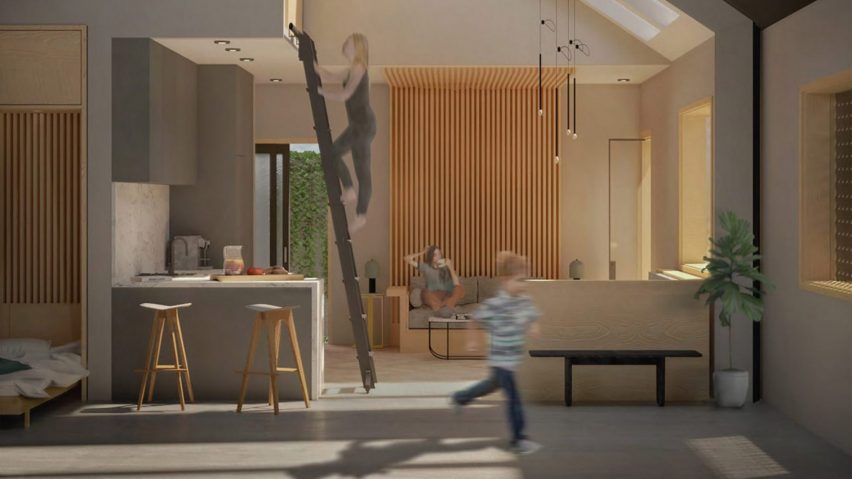Dezeen School Shows: we've rounded up six student projects featured in Dezeen School Shows that experiment with modular design.
These design students have proposed furniture, interior and architecture projects that utilise various module combinations to create customisable and personalised structures that address sustainability issues, overcrowding, food crises and social factors.
This roundup of projects includes houses that can expand and contract to resolve urban overpopulation and a building constructed using artificial intelligence.
The selection of projects comes from interior design, architecture, city design, environmental design, engineering and architectural design and vertical design courses at international institutions including Ryerson University, L'École de design Nantes Atlantique, University of Nottingham, Rensselaer Polytechnic Institute and Bartlett School of Architecture.
Shift by Grace Robertson
Interior design student Grace Robertson designed a collection of modular furniture pieces, aiming to create versatile pop-up retail stores to encourage in-person shopping after the Covid-19 pandemic.
The modules can be assembled in various combinations to accommodate all types of vendors and create variety within the space.
"The need for cycling vendors was the best way to accommodate the current economic climate and pique enough interest to entice shoppers to venture to leave the safety of their homes in a pandemic," explained Robertson.
"The display furniture pieces compose a puzzle and can be shifted around for display configurations, seating, and platforms and packed away for an open area."
Student: Grace Robertson
School: Ryerson University
Course: Interior Design Studio III
Mum by Clara Tortorici
Clara Tortorici created a collection of modular urban furniture called Mum while studying city design. The collection aims to encourage social interaction within urban environments.
Mum consists of solid and hollow modules, creating a variety of combinations that can alter how people interact with the structure and with each other.
"Its bevelled shape suggests a gap to be filled," explained Tortorici. "The solid and hollow parts make it possible to assemble laterally or vertically."
"Finally, the addition of modules influences the choice of activity: sitting, playing, socialising, being alone, or simply soaking up some rays."
Student: Clara Tortorici
School: L'École de design Nantes Atlantique
Course: MDes City Design
Perpendicular Neighbours by Alice O'Brien
Architecture student Alice O'Brien designed a modular apartment complex, which aims to create a zero-waste neighbourhood in the city.
According to O'Brien, it provides residents with the creative freedom to personalise their homes, creating harmony between living, work and leisure.
"Perpendicular Neighbours explores the pioneering potential of lightweight, renewable materials and construction methods," said O'Brien. "It prioritises innovative yet simple tectonics, enabling the scheme to be responsive and repeatable."
"Learning from the past mistakes of Leeds' social housing, this scheme utilises progressive and affordable solutions as well as collaborative design practices to embrace the contemporary shift in residential architecture."
Student: Alice O'Brien
School: University of Nottingham
Courses: Bachelor of Architecture BArch (ARB/RIBA Part 1) and Architecture and Environmental Design MEng (ARB/RIBA Part 1 CIBSE)
Cultivate by Megumi Call and Tommy Giordano
Exploring solutions to resolve the food crisis in Co-op City, USA, design students Megumi Call and Tommy Giordano integrated a multi-use centre within an existing building complex.
The centre aims to grow and sell produce and build a community. It features vertical farms, dining facilities, retail and workshops.
"With 110,000 square feet of vertical farms, Cultivate tackles Co-op City's food crisis through its dining and retail spaces, [stimulating] commerce in this predominantly residential area, and dedicated workspaces that provide the community with accessible educational resources," explained Call and Giordano.
"From interlocking plant pods to modular program units, Cultivate is a sustainable and scalable response to the multifaceted needs of Co-op City."
Students: Megumi Call and Tommy Giordano
School: Rensselaer Polytechnic Institute
Course: Vertical Design Studio, third, fourth, fifth-year
AI Pixel Parasite by Andreea Dumitrescu
Engineering and architectural design student Andreea Dumitrescu designed an artificial intelligence (AI) research lab and data centre that is composed of modular cubes arranged by machine learning algorithms.
Aiming to reduce the negative environmental effects of construction, this project explored how AI can design and construct a building by observing and adapting to its surroundings.
"Located on the former site of Coleg Harlech in North Wales, this proposal is an AI research lab and data centre, contrasting and complimenting the existing structures," said Dumitrescu.
"Powered by a nuclear battery developed by ANPEG, its dynamic growth evolves to meet the progressing demands of the data centre in an intelligent and adaptable framework."
Student: Andreea Dumitrescu
School: Bartlett School of Architecture
Course: Engineering and Architectural Design MEng
Move Laneway by Nicolas Burbano Diaz
Driven by the overwhelming population density in urban environments, interior design student Nicolas Burbano Diaz proposed a home that can expand and contract to suit the needs of its owner and the environment.
The modular design allows residents to adapt the dwelling to their lifestyle or living situations, making it suitable for a wide range of home seekers.
"The Move Laneway house is a prototype that addresses the challenges faced in increasing urban density through an expandable house structure that incorporates multi-functional systems to create flexible micro-living spaces," said Diaz.
"A key objective was to offer people the option to live in a smaller footprint that is 52 square meters when contracted or a total of 77 square meters when expanded."
Student: Nicolas Burbano Diaz
School: Ryerson University
Course: Interior Design Studio II
Partnership content
These projects are presented in school shows from institutions that partner with Dezeen. Find out more about Dezeen partnership content here.

